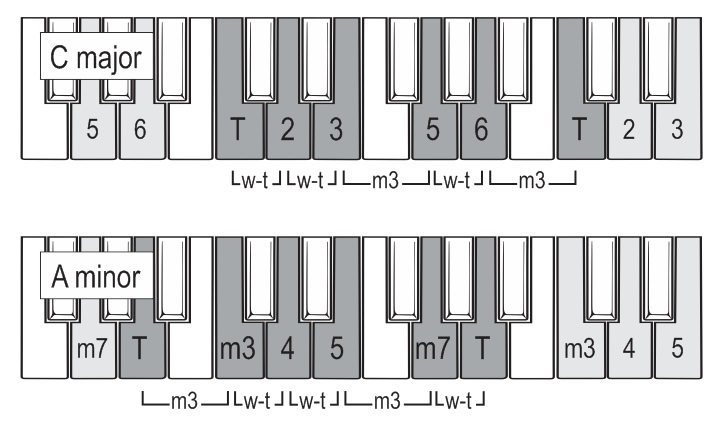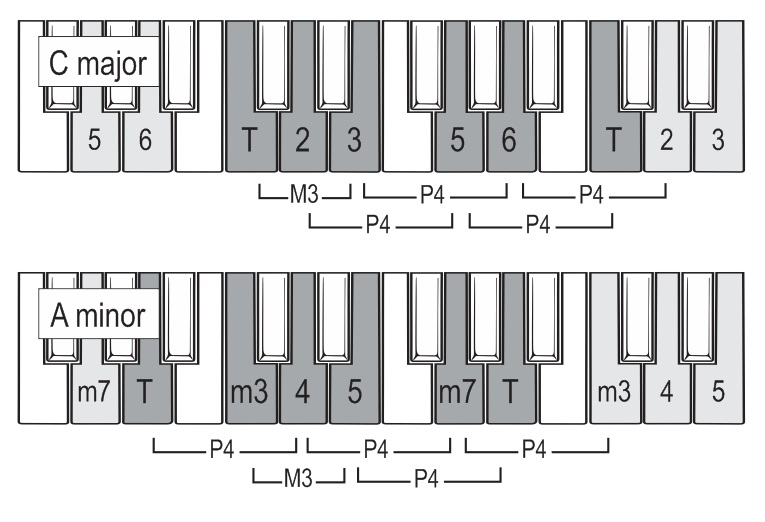Patreon MUSICARTA Premium
Pentatonic Hanon Exercises
~ PentHan 01-12-20 ~
~ Play-by-ear Page 1 ~
Pentatonic Hanon 01-12-20 is a substantial lesson series which drills the major pentatonic scales in triplets with repeated notes - a great way to practice the keyboard dexterity required for improvising.
This is the first page of the three PentHan 01-12-20 play-by-ear pages. To get the most out of this mini-series, start from Page One.
The patterns in the PentHan 01-12-20 series - and elsewhere in Musicarta - are described in terms of step (S), skip (K) and repeat (R) - 'SKR' notation.
But because the pentatonic scale-tones are not evenly spread, it can be challenging at first to see-and-hear the difference between steps (to next-door notes) and skips (to next-but-one notes) in the pentatonic scales.
Here's a repeat of the step, skip, repeat 'briefing' from the series home page, plus three practice videos to help you 'get your ear in'.
Step, skip, repeat
Pattern is incredibly useful for musical creativity, and the PentHan 01-12-20 lesson series explicitly uses pattern as a technique for improvising a melodic line.
Simple melodic-line patterns can be described in terms of steps - to a next-door scale tone, either up or down ('S'), skips - to a next-but-one scale tone, ditto ('K'), or repeats - repeating the same note ('R').
The PentHan 01-12-20 patterns are described in terms of pentatonic scale steps, skips and repeats, but because the pentatonic scale is 'gappy', they're not so immediately obvious.
Pentatonic scale - Steps
In both the major and minor pentatonic scales, steps - moving to a next-door pentatonic scale tone ('S') - can be either whole tones (w-t) or minor thirds (m3):
 Steps (S) in the pentatonic scales
Steps (S) in the pentatonic scalesThere are three whole-tone (w-t) steps and two minor third (m3) steps in the pentatonic scales.
Here's a video run-through of the steps and skips in the pentatonic scales.
Pentatonic scale - Skips
Skips - moving to a next-but-one pentatonic scale tone ('K') can be either a major third (M3) or a perfect
fourth (P4).
 Skips (K) in the pentatonic scales
Skips (K) in the pentatonic scalesIn the pentatonic scales, there are four perfect fourth (P4) skips and one major third (M3) skip.
Here are three videos to help you recognise (next-door) steps and (next-but-one) skips.
The first plays a simple step-step-skip (SSK) in C, B flat and D - three of our play-by-ear keys.
Sing along!
'Singing along' is very helpful in sensing the up/down contour of a melodic line and the size of the jumps. It doesn't matter at all how 'good' ('in tune') you are. Simply trying adds another dimension to your appreciation of 'interval' (musical jump). So, try it!
Transposing/visualising exercises
You don't have to be 'singing in the right key' in order to rehearse and visualise these patterns, learning the pentatonic scales and practicing 'seeing the music in the keyboard'.
Here are two more videos, showing our reference pattern in C in the middle, and, first, the A and E flat versions playing below and above. (That's a minor third above and below, both two-black-key pentatonic scale.)
Now with C in the middle and A flat and E either side - a major third above and below, three-black-key scales.
Now back to the play-by-ear material, and an overview of how the exercises are laid out.
The Play-by-ear pages
The patterns (Nos.1-12 and mixed pairs Nos.1-8) are shown:
- In single line 'in-any-key' notation, with
- Pentatonic scale-degree notation (T-2-3-5-6) above, and
- SKR (step, skip, repeat) notation below.
(Two diagrams - rising and falling).


Then you are offered an audio performance of the pattern, in C, with the tonic sounded first and "four in".
You should be able to play along with this performance!
Next, you have two 'Random tonic' examples to play.
The 'Performance' audio is the same format as the demonstration performance in C. You are given a tonic (Ab, A, Bb, C, D, Eb or E), which you identify by ear.
You will then try, 'transposing by ear' and with the help of the notated diagram, to play the pattern in the new key.
If you need a more gradual approach, the performance is followed by the build-up audio. This video explains how the build-up audio is structured.
This should give you enough opportunity to master the pattern 'by ear'.
(In fact, anybody would profit from working through this build-up - 'doodling' rhythmic and dynamic variations during the 'easy bits', and putting in the practice time to develop familiarity with these essential scales and creative awareness of the step-skip-repeat patterning to generate solos!)
A Random Tonic 2 'performance' and 'build-up' are then given. Identify the tonic (Ab, A, Bb, C, D, Eb or E); pause the video, and work out the performance from the notation - or by just transposing in your head.
Check your performance against the rest of the performance audio, or use the build-up audio to structure your practice.
Consciously use this process to increase your creative autonomy!
Play-by-ear Page 1: Patterns 1 to 6
PentHan 01-12-20 No.1


Performance in C
Random Tonic 1: Performance
Random Tonic 1: Build-up
Random Tonic 2: Performance
Random Tonic 2: Build-up
PentHan 01-12-20 No.2


Performance in C
Random Tonic 1: Performance
Random Tonic 1: Build-up
Random Tonic 2: Performance
Random Tonic 2: Build-up
PentHan 01-12-20 No.3


Performance in C
Random Tonic 1: Performance
Random Tonic 1: Build-up
Random Tonic 2: Performance
Random Tonic 2: Build-up
PentHan 01-12-20 No.4


Performance in C
Random Tonic 1: Performance
Random Tonic 1: Build-up
Random Tonic 2: Performance
Random Tonic 2: Build-up
PentHan 01-12-20 No.5


Performance in C
Random Tonic 1: Performance
Random Tonic 1: Build-up
Random Tonic 2: Performance
Random Tonic 2: Build-up
PentHan 01-12-20 No.6


Performance in C
Random Tonic 1: Performance
Random Tonic 1: Build-up
Random Tonic 2: Performance
Random Tonic 2: Build-up
Now go on to the next play-by-ear page.
|
OUT NOW! |
THE MUSICARTA BEAT & RHYTHM WORKBOOK At last! An effective approach to keyboard rhythm & syncopation skills. Learn more! |
ONLY $24.95! |
Patreon
|
The MusicartaA methodical approach to keyboard syncopation for
|
PUBLICATIONS
exciting keyboard
creativity courses
CHORDS 101
WORKBOOK

~HANON~
video course

Musicarta
Patreon
PENTATONICS
WORKBOOK
video course

Creative Keyboard
video course

BEAT AND RHYTHM
WORKBOOK

- Volume 1 -

12-BAR PIANO
STYLES WORKBOOK

MUSICARTA MODES
WORKBOOK

PIANO STYLE

CANON PROJECT
video course

VARIATIONS
video course


- Piano Solo -
video course

- Piano Solo -


YouTube playlists





 THE LOGO
THE LOGO
